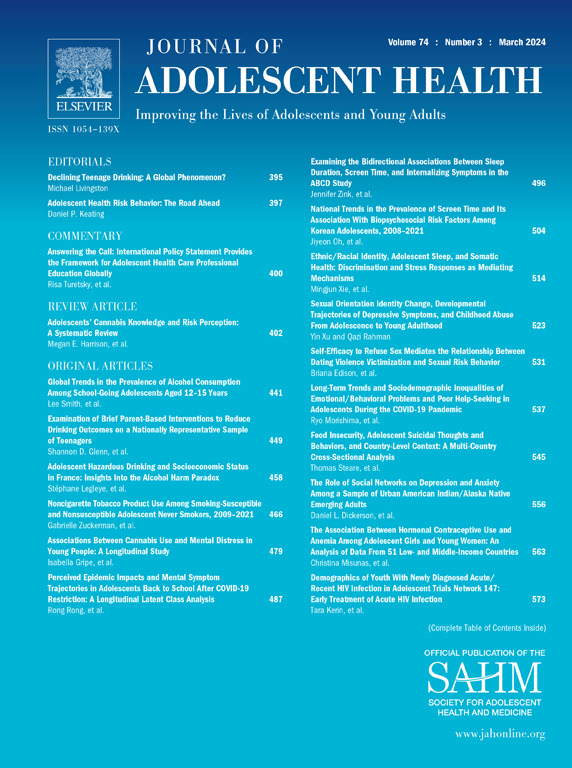加拿大安大略省儿科和青壮年急诊就诊者药物使用情况的医生随访。
IF 5.5
2区 医学
Q1 PEDIATRICS
引用次数: 0
摘要
目的:研究安大略省青少年在药物相关急诊室(ED)就诊后 60 天内接受门诊医生随访的比例和预测因素:我们研究了 COVID-19 大流行之前和期间加拿大安大略省 10-24 岁青少年药物相关急诊就诊的管理数据。与药物相关的就诊使用《国际疾病分类-10-CA》代码进行识别。我们描述了人口统计学特征、就诊前一年接受心理健康服务的情况、就诊后的处置情况以及就诊后 60 天内的后续服务情况:结果:2017 年 4 月 1 日至 2021 年 5 月 31 日期间,64236 名青少年至少有一次因使用药物而到急诊室就诊。因饮酒就诊的人数最多(49%),其次是大麻(32.3%)。大流行期间,除酒精外,所有药物的急诊就诊率均高于大流行前。因使用药物而接受医生随访的比例较低(大流行前为 33.2%),但在大流行期间则有所上升(41.7%;调整后的几率比为 1.34,95% CI 为 1.28,1.39),而且不同药物的随访率也不尽相同。与药物相关的急诊就诊前一年的心理健康服务史与 60 天内接受医生复诊的关系最为密切(调整后的几率比 6.86,95% CI 6.57,7.17):讨论:尽管在虚拟医疗实施后的大流行病期间,随访比例较高,但青少年往往不会在药物相关急诊就诊后两个月内接受医生随访。需要进一步研究了解复诊率低的原因,并研究可提高复诊率的干预措施。本文章由计算机程序翻译,如有差异,请以英文原文为准。
Physician Follow-Up of Pediatric and Young Adult Emergency Department Visits for Substance Use in Ontario, Canada
Purpose
To study the proportion and predictors of outpatient physician follow-up within 60 days of substance-related emergency department (ED) visits for Ontario youth.
Methods
We examined administrative data on substance-related ED visits before and during the COVID-19 pandemic among youths aged 10–24 years in Ontario, Canada. Substance-related visits were identified using International Classification of Diseases-10-CA codes. We described demographic characteristics, receipt of mental health services in the year before the ED visit, disposition from the ED, and follow-up services within 60 days of the ED visit.
Results
Between April 1, 2017, and May 31, 2021, 64,236 youth had at least one ED visit for substance use. Visits for alcohol were the most common (49%), followed by cannabis (32.3%). ED visits for all substances were more prevalent during the pandemic than prepandemic, except visits for alcohol. The receipt of follow-up physician care for substance use was low (33.2% prepandemic) but increased during the pandemic (41.7%; adjusted odds ratio 1.34, 95% CI 1.28, 1.39) and varied between substances. Mental health service history in the year before the substance-related ED visit had the strongest association with receipt of follow-up physician care within 60 days (adjusted odds ratio 6.86, 95% CI 6.57, 7.17).
Discussion
Youth frequently do not receive physician follow-ups within two months of the substance-related ED visit, although higher follow-up proportions were seen during the pandemic after the implementation of virtual care. Further research is required to understand why follow-up is low and to examine interventions that can increase connection to care.
求助全文
通过发布文献求助,成功后即可免费获取论文全文。
去求助
来源期刊

Journal of Adolescent Health
医学-公共卫生、环境卫生与职业卫生
CiteScore
10.40
自引率
3.90%
发文量
526
审稿时长
46 days
期刊介绍:
The Journal of Adolescent Health is a scientific publication dedicated to enhancing the health and well-being of adolescents and young adults. Our Journal covers a broad range of research topics, spanning from the basic biological and behavioral sciences to public health and policy. We welcome a variety of contributions, including original research papers, concise reports, literature reviews, clinical case reports, opinion pieces, and letters to the editor. We encourage professionals from diverse disciplines such as Anthropology, Education, Ethics, Global Health, Health Services Research, Law, Medicine, Mental and Behavioral Health, Nursing, Nutrition, Psychology, Public Health and Policy, Social Work, Sociology, and Youth Development to share their expertise and contribute to our mission of promoting adolescent health. Moreover, we value the voices of young individuals, family and community members, and healthcare professionals, and encourage them to submit poetry, personal narratives, images, and other creative works that provide unique insights into the experiences of adolescents and young adults. By combining scientific peer-reviewed research with creative expressions, our Journal aims to create a comprehensive understanding of the challenges and opportunities in adolescent and young adult health.
 求助内容:
求助内容: 应助结果提醒方式:
应助结果提醒方式:


